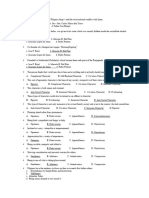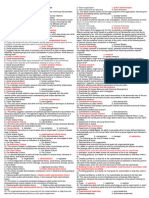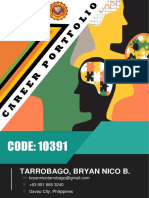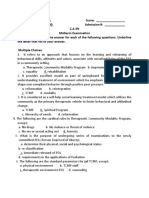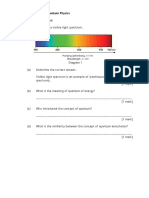Questioned Document Examination: An Instructional Material For Criminology Students With Laboratory Manual
Questioned Document Examination: An Instructional Material For Criminology Students With Laboratory Manual
Uploaded by
A plus Educational CenterCopyright:
Available Formats
Questioned Document Examination: An Instructional Material For Criminology Students With Laboratory Manual
Questioned Document Examination: An Instructional Material For Criminology Students With Laboratory Manual
Uploaded by
A plus Educational CenterOriginal Title
Copyright
Available Formats
Share this document
Did you find this document useful?
Is this content inappropriate?
Copyright:
Available Formats
Questioned Document Examination: An Instructional Material For Criminology Students With Laboratory Manual
Questioned Document Examination: An Instructional Material For Criminology Students With Laboratory Manual
Uploaded by
A plus Educational CenterCopyright:
Available Formats
91.
There is a principle in handwriting identification, which states that a man cannot forge his
signature.
al At best. he can only disguise it c. Yes, man can forge his own signature
b. No, man cannot forge his own signature d. None of the above
92. It is true that genuine writing by the same writer does vary and in an examination of
questioned writing this phase of the subject should always receive careful attention. This
theory is -
a. Variation in genuine writing c. Disparity in open writing
b. Difference in honest writing d. Distinction in unpretentious writing
93. It refers to a writer who has appropriately been called "an assassin of character and these
strange missives are often property describe as 'poison pen letters".
a. Nameless writing c. Unidentified writing
b. Mysterious writing d. Anonymous writing
94. A signature that is produced by the cooperation of two hands and two minds will usually
show evidence of unnaturalness in the signature itself that is inconsistent with forgery is
called-
a. Guided hand or assisted signatures c. Steered hand signatures
b. Directed hand signatures d. Showed hand signatures
95. It emphasized the order of writing as shown by crosses strokes that there are many
common of us never see with the mind is called-
a. Order of traversed strokes c. Sequence of crossed strokes
b. Arrangement of spanned strokes d. Classification of overlapped strokes
96. Refers to the theory in document examination like many other kinds of fraudulent creations,
forged documents are sometimes made to look old in order to make them appear genuine
and a questioned document should be promptly investigated in every possible manner.
a. Time of documents c. Period of documents
b. Age of documents d. Era of documents
97. The instrument which makes it possible to see physical evidence directly that otherwise
might be invisible but its application to the investigation of documents is not so \A/3H
understood is called-
a. Micrometer c. Magnetic lens
b. Microscope d. magnifying lens
98. The compound microscope has two systems of lenses for greater magnification:
a. The ocular, or eyepiece lens that one looks into and the objective lens. or the lens
closest to the object
b. The stereoscopic microscope and the comparison microscopes.
c. Both A & B
d. None of the above
Questioned Document Examination:
An Instructional Material for Criminology Students with Laboratory Manual
You might also like
- Industrial Security Sas-11-Cri-178-1Document6 pagesIndustrial Security Sas-11-Cri-178-1Hilron DioknoNo ratings yet
- Metamaterials Presentation 4Document31 pagesMetamaterials Presentation 4Margie GuerreroNo ratings yet
- A Mayor Executed A Document in His Legal CapacityDocument8 pagesA Mayor Executed A Document in His Legal CapacityEmmanuel BuanNo ratings yet
- SAS 2 CRI 188 Therapeutic ModalitiesDocument6 pagesSAS 2 CRI 188 Therapeutic ModalitiesKaren Angel AbaoNo ratings yet
- CLJ Final Coaching Human Rights EducationDocument27 pagesCLJ Final Coaching Human Rights EducationXandredg Sumpt LatogNo ratings yet
- Theoretical and Conceptual FrameworkDocument5 pagesTheoretical and Conceptual Frameworkdalalbota100% (1)
- Cor Ad Q and A 100Document15 pagesCor Ad Q and A 100RamirezNo ratings yet
- Criminal Jurisprudence Procedure and Evidence (20%)Document13 pagesCriminal Jurisprudence Procedure and Evidence (20%)RODOLFO JR. CASTILLONo ratings yet
- Cri 412 - Uloa SimDocument32 pagesCri 412 - Uloa SimDaniel Tajas BorromeoNo ratings yet
- Character Evidence Not Generally Admissible ExceptionsDocument4 pagesCharacter Evidence Not Generally Admissible Exceptionslen_dy010487No ratings yet
- Crim 1 Memory AidDocument22 pagesCrim 1 Memory AidElla B.No ratings yet
- 2 Final Briefing Cdi 2015Document16 pages2 Final Briefing Cdi 2015Johnpatrick DejesusNo ratings yet
- Pre Test 2020 CoradDocument3 pagesPre Test 2020 CoradJamella GarzonNo ratings yet
- CFLM RedtipsDocument5 pagesCFLM RedtipsEscala, John KeithNo ratings yet
- CRI 175 Question and AnswerDocument7 pagesCRI 175 Question and AnswerciangyechengNo ratings yet
- Classes of Smokeless Powder: Group 2 (4 Reporter)Document34 pagesClasses of Smokeless Powder: Group 2 (4 Reporter)Lenie GeronoNo ratings yet
- Lea4 Reviewer PrelimDocument19 pagesLea4 Reviewer PrelimCalvinderwin MatanguihanNo ratings yet
- g2 Jul Aug2024 Crim Bet by Prof. Toliao Answer KeyDocument82 pagesg2 Jul Aug2024 Crim Bet by Prof. Toliao Answer KeyNorsidah DomatoNo ratings yet
- G1-Jul-Aug2024-Ca-Bet by Prof. DayagroDocument19 pagesG1-Jul-Aug2024-Ca-Bet by Prof. DayagroMelanie Garcia CanonizadoNo ratings yet
- Cri 228 Ulo ADocument69 pagesCri 228 Ulo ABeltcarl Anthony Lamigo BacalsoNo ratings yet
- CRIMSOCDocument28 pagesCRIMSOCKenneth FernandezNo ratings yet
- Module in Fire Technology and Arson Investigation (Cdi 6)Document4 pagesModule in Fire Technology and Arson Investigation (Cdi 6)Givehart Mira BanlasanNo ratings yet
- CRIMINAL Law 1Document13 pagesCRIMINAL Law 1Jaden Fate SalidaNo ratings yet
- Specialized Crime Investigation: With Legal MedicineDocument4 pagesSpecialized Crime Investigation: With Legal MedicineApple AsneNo ratings yet
- Lie Detection FinalDocument13 pagesLie Detection FinalIrene AlejandroNo ratings yet
- Case Study Conviction Through Enhanced Fingerprint IdentificationDocument3 pagesCase Study Conviction Through Enhanced Fingerprint IdentificationMalibog Ako0% (1)
- Lesson 4.3softDocument9 pagesLesson 4.3softYvetteNo ratings yet
- Career Portfolio SampleDocument11 pagesCareer Portfolio SampleGabrielle AnNo ratings yet
- Extinction of Criminal LiabilityDocument2 pagesExtinction of Criminal LiabilityJustine M.No ratings yet
- Correctional Administration Review QuestionsDocument12 pagesCorrectional Administration Review QuestionsSofia Bien MarieNo ratings yet
- CA Correctional InstitutionDocument51 pagesCA Correctional InstitutionAlexander FutalanNo ratings yet
- People vs. QuimzonDocument21 pagesPeople vs. QuimzonCinja ShidoujiNo ratings yet
- How To Effectively Hurdle The Board Examination For Criminologist by Charlemagne James P. RamosDocument68 pagesHow To Effectively Hurdle The Board Examination For Criminologist by Charlemagne James P. RamosJules Karim A. AragonNo ratings yet
- Exam Maam SDocument6 pagesExam Maam SHECTOR LAWAGNo ratings yet
- Lecture 7 - Custodial InvestigationDocument3 pagesLecture 7 - Custodial Investigationnotgacount000No ratings yet
- g64c Pulis Ka Na Ba Lived Experiences of Criminology Students Dealing With Social StereotypesDocument29 pagesg64c Pulis Ka Na Ba Lived Experiences of Criminology Students Dealing With Social StereotypesBigboy shankNo ratings yet
- Burden of Proof and Presumptions (Rule 131)Document8 pagesBurden of Proof and Presumptions (Rule 131)Maria LopezNo ratings yet
- Traffic Summative TestDocument3 pagesTraffic Summative TestricorubilynNo ratings yet
- CA 102 NotesDocument23 pagesCA 102 Notesikyr beatingoNo ratings yet
- Final Coaching Law Enforcement Administration: Politeia Which MeansDocument19 pagesFinal Coaching Law Enforcement Administration: Politeia Which MeansHope Hadji AliNo ratings yet
- Guidelines For Accomplishing The 2011 Revised Format of The Psir 2Document8 pagesGuidelines For Accomplishing The 2011 Revised Format of The Psir 2Mhelody Gutierrez BelmonteNo ratings yet
- Criminology Refresher ReviewerDocument99 pagesCriminology Refresher Reviewerlea karen GelidoNo ratings yet
- Cdi 4 Lesson 4Document17 pagesCdi 4 Lesson 4Hanz MoralesNo ratings yet
- Pointers To Review For Institutional CorrectionsDocument15 pagesPointers To Review For Institutional Correctionscaraigbryan145No ratings yet
- Buk 1 2014-2015Document246 pagesBuk 1 2014-2015Riza PerdidoNo ratings yet
- Yllana Bay View College Balangasan District Pagadian City: "The Builder of Future Leaders"Document1 pageYllana Bay View College Balangasan District Pagadian City: "The Builder of Future Leaders"Criseljosa LacapagNo ratings yet
- CDIDocument5 pagesCDImark dave omalzaNo ratings yet
- Crim 5 Midterm ExamDocument7 pagesCrim 5 Midterm ExamRhea Lynne DagatanNo ratings yet
- Jp-03-Criminal EvidenceDocument14 pagesJp-03-Criminal EvidenceJvnRodz P GmlmNo ratings yet
- Ca 1 Institutional CorrectionsDocument26 pagesCa 1 Institutional CorrectionsJustine Jay ElegadoNo ratings yet
- POLYGRAPHYDocument6 pagesPOLYGRAPHYVenus ClaudNo ratings yet
- CA 3 Module 1 AnsDocument4 pagesCA 3 Module 1 AnsSelaznom MoonchAserNo ratings yet
- Crim Pro Definition of TermsDocument3 pagesCrim Pro Definition of TermsAguilar John Francis100% (1)
- CLJ Final Coaching Evidence and Criminal ProcedureDocument148 pagesCLJ Final Coaching Evidence and Criminal ProcedureXandredg Sumpt LatogNo ratings yet
- CLJ 1 Quiz ReviewerDocument4 pagesCLJ 1 Quiz ReviewerAliyusop PiangNo ratings yet
- FC Socio 4-23Document1,099 pagesFC Socio 4-23Mary Grace UbaNo ratings yet
- Art That Deals With The Identity and Location Systematic Method of InquiryDocument11 pagesArt That Deals With The Identity and Location Systematic Method of InquiryVanessa Mae Tangian LabradoNo ratings yet
- Inbound 7724958247648964946Document109 pagesInbound 7724958247648964946John Kenneth C. LorenzoNo ratings yet
- CA 2 - Summer Modular Class (Final)Document17 pagesCA 2 - Summer Modular Class (Final)Belinda ViernesNo ratings yet
- Review Questions in Law Enforcement Administration Set One INSTRUCTION: Select The Correct Answer For Each of The FollowingDocument30 pagesReview Questions in Law Enforcement Administration Set One INSTRUCTION: Select The Correct Answer For Each of The FollowingChester CuarentasNo ratings yet
- Questioned Document CriminalisticsDocument4 pagesQuestioned Document CriminalisticsArgie DionioNo ratings yet
- Tomas Claudio Colleges: Basic Education Department Junior High School S.Y. 2021 - 2022 Moving-Up and Recognition AwardsDocument17 pagesTomas Claudio Colleges: Basic Education Department Junior High School S.Y. 2021 - 2022 Moving-Up and Recognition AwardsA plus Educational CenterNo ratings yet
- Affidavit of Desistance: AffiantDocument1 pageAffidavit of Desistance: AffiantA plus Educational CenterNo ratings yet
- Criminologist Board Exam RequirementsDocument1 pageCriminologist Board Exam RequirementsA plus Educational Center100% (1)
- Technical English 1 FINAL EXAMDocument5 pagesTechnical English 1 FINAL EXAMA plus Educational CenterNo ratings yet
- Group 3 Chapter 1 5Document70 pagesGroup 3 Chapter 1 5A plus Educational CenterNo ratings yet
- Between The Question and The Choices 3. A. FingerprintDocument1 pageBetween The Question and The Choices 3. A. FingerprintA plus Educational CenterNo ratings yet
- Final Review Exercises in Science K-1Document2 pagesFinal Review Exercises in Science K-1A plus Educational CenterNo ratings yet
- Final Exam - Comparative Models in PolicingDocument2 pagesFinal Exam - Comparative Models in PolicingA plus Educational CenterNo ratings yet
- Midterm Exam - PolygraphyDocument4 pagesMidterm Exam - PolygraphyA plus Educational CenterNo ratings yet
- 5 Set Questions 2076Document9 pages5 Set Questions 2076Rabindra Raj BistaNo ratings yet
- Electric and Magnetic Fields Answers To Week 4 AssignmentDocument3 pagesElectric and Magnetic Fields Answers To Week 4 AssignmentShootingStarPhotonsNo ratings yet
- Boundry Condition 1Document12 pagesBoundry Condition 1Jasleen KaurNo ratings yet
- 3 The Effect of Dielectric and Magnetic Media On Electric and Magnetic FieldsDocument44 pages3 The Effect of Dielectric and Magnetic Media On Electric and Magnetic Fieldsdhook_mmmNo ratings yet
- Laser Safety Program: ScopeDocument6 pagesLaser Safety Program: ScopeAhmedAhmedNo ratings yet
- Solutions To Problems: Chapter 25 Problems Appeared On The End of Chapter 25 of TheDocument3 pagesSolutions To Problems: Chapter 25 Problems Appeared On The End of Chapter 25 of Theiolkos11No ratings yet
- Third Periodical Test - For ReDocument3 pagesThird Periodical Test - For ReJessica Manawes NavorNo ratings yet
- Ruby LaserDocument3 pagesRuby LaserOsaja AliNo ratings yet
- Mitutoyo - Projektory Pomiarowe PJ, PV I PH - E14005 - 2013 ENDocument20 pagesMitutoyo - Projektory Pomiarowe PJ, PV I PH - E14005 - 2013 END.T.No ratings yet
- 4C plc8 Lens 14Document3 pages4C plc8 Lens 14Soji AdimulaNo ratings yet
- Daylight in ArchitectureDocument39 pagesDaylight in ArchitectureGopi KrishnaNo ratings yet
- Physics Question BanksDocument32 pagesPhysics Question Banksthuthao2007No ratings yet
- Jom Skor A+ Fizik: Quantum PhysicsDocument7 pagesJom Skor A+ Fizik: Quantum Physicsmrsm fizikNo ratings yet
- Study Material: Downloaded From VedantuDocument26 pagesStudy Material: Downloaded From VedantukamalNo ratings yet
- Optoelectronic Devices and Sensors: Presented byDocument25 pagesOptoelectronic Devices and Sensors: Presented byDarrell Justin AbugNo ratings yet
- The Different Types of MicroscopesDocument7 pagesThe Different Types of MicroscopesJayati AroraNo ratings yet
- HeNe LaserDocument3 pagesHeNe Laserh4773rNo ratings yet
- Anna UniversityDocument4 pagesAnna UniversityPalani PicoNo ratings yet
- Rotational DynamicsDocument91 pagesRotational DynamicsYugandhar VeeramachaneniNo ratings yet
- Important Questions For CBSE Class 9 Science Work, Power and EnergyDocument2 pagesImportant Questions For CBSE Class 9 Science Work, Power and Energyshashank srivastavaNo ratings yet
- Activity 1 MicroscopeDocument7 pagesActivity 1 MicroscopeRalc RamsNo ratings yet
- Newton's Experiments On LightDocument5 pagesNewton's Experiments On LightShauna Prettygyol HamilNo ratings yet
- To The Sem/Eds or "Every Composition Tells A Story" John T. Cheney and Peter D. CrowleyDocument4 pagesTo The Sem/Eds or "Every Composition Tells A Story" John T. Cheney and Peter D. CrowleyJohnNo ratings yet
- Electromagnetic Induction - 6 (I) Multiple Choice QuestionsDocument7 pagesElectromagnetic Induction - 6 (I) Multiple Choice QuestionsAnvita PrakashNo ratings yet
- Ultrasonic Diffraction by A Straight EdgeDocument5 pagesUltrasonic Diffraction by A Straight EdgeJose GalvanNo ratings yet
- Circle of ConfusionDocument17 pagesCircle of ConfusionArturo Forton CuñaNo ratings yet
- OcnDocument2 pagesOcnRaji SharmiNo ratings yet
- Our World May Be A Giant HologramDocument5 pagesOur World May Be A Giant HologramRedzaNo ratings yet
- Instruction For Vector Optics Sentinel-X 10-40x56 RiflescopeDocument2 pagesInstruction For Vector Optics Sentinel-X 10-40x56 RiflescopeSanti JubéNo ratings yet













